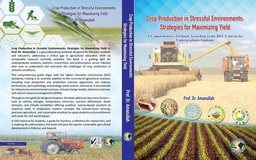Sustainable Nutrient Management in Rice: Unlocking the Potential of Zinc and Phosphorus in Rice–Wheat Systems
Published in Earth & Environment and Agricultural & Food Science

Sustainable Nutrient Management in Rice: Unlocking the Potential of Zinc and Phosphorus in Rice–Wheat Systems
Inamullah and Amanullah, Department of Agronomy, The University of Agriculture, Peshawar, January 2014
Introduction
The rice-wheat cropping system is a cornerstone of agriculture in Northwest Pakistan. To maximize the productivity of this system, effective nutrient management is crucial. This article explores the role of zinc (Zn) and phosphorus (P) in optimizing rice and wheat yields, with a focus on enhancing sustainability and profitability. The study evaluates the impact of different nutrient levels on crop performance and provides practical insights for farmers and policymakers.
Objectives
-
Evaluate the individual and combined effects of different levels of phosphorus (P) and zinc (Zn) on growth, yield, and profitability of fine and coarse rice genotypes.
-
Determine the residual effects of applied P and Zn on the productivity and profitability of the subsequent wheat crop.
-
Assess differential nutrient uptake among rice genotypes and its impact on soil nutrient status.
-
Develop site-specific nutrient management strategies to enhance sustainability in the rice-wheat cropping system of Northwest Pakistan.
Key Findings and Recommendations
-
The application of 120 kg P ha⁻¹ and 10 kg Zn ha⁻¹ significantly increased rice and subsequent wheat yields, as well as overall profitability, compared to control and lower nutrient levels.
-
Coarse rice genotypes, particularly Pukhraj, outperformed the fine genotype (B-385) in yield and profitability. However, they depleted more P and Zn from the soil, negatively affecting subsequent wheat performance.
-
The fine genotype (B-385) contributed to higher residual P and Zn in the soil, benefiting the succeeding wheat crop.
-
It is recommended that farmers apply 120 kg P and 10–15 kg Zn ha⁻¹ for coarse rice genotypes, or supplement wheat crops with additional fertilizers when grown after high-yielding rice cultivars to sustain system productivity.
Practical Implications for Stakeholders
-
Farmers: Implementing site-specific nutrient management strategies (e.g., applying 120 kg P and 10 kg Zn ha⁻¹) and choosing suitable rice genotypes like Pukhraj can boost crop productivity and profitability. However, additional fertilization for wheat is necessary after coarse rice varieties.
-
Policymakers: Fertilizer subsidy and extension policies should prioritize balanced nutrient management tailored to genotype-specific responses and the residual effects of fertilizers, especially in rice-wheat systems.
-
Researchers & Agronomists: Further multi-location research on phosphorus-zinc interactions and genotype-specific nutrient strategies is necessary to optimize resource use efficiency across different agro-ecological zones.
Significant Publications
-
Amanullah and Inamullah. 2015. Preceding rice genotypes, residual phosphorus and zinc influence harvest index and biomass yield of subsequent wheat crop under rice-wheat system. Pakistan J. Botany. 47(SI): 265-273.
-
Amanullah and Inamullah. 2016. Dry matter partitioning and harvest index differ in rice genotypes with variable rates of phosphorus and zinc nutrition. Rice Science. 23(2): 78-87.
-
Amanullah and Inamullah. 2016. Residual phosphorus and zinc influence wheat productivity under rice–wheat cropping system. SpringerPlus. 5:255 (DOI: 10.1186/s40064-016-1907-0).
-
Amanullah, Inamullah, Z. Shah, and S.K. Khalil. 2016. Phosphorus and zinc interaction influence leaf area index in fine versus coarse rice (Oryza sativa L.) genotypes in Northwest Pakistan. J. Plant Stress Physiol. 2: 1-8.
-
Amanullah; Inamullah; Alkahtani, J.; Elshikh, M.S.; Alwahibi, M.S.; Muhammad, A.; Imran; Khalid, S. 2020. Phosphorus and Zinc Fertilization Improve Productivity and Profitability of Rice Cultivars under Rice-Wheat System. Agronomy, 10: 1085.
-
Amanullah; Inamullah; Alwahibi, M.S.; Elshikh, M.S.; Alkahtani, J.; Muhammad, A.; Khalid, S.; Imran; Ahmad, M.; Khan, N.; Ullah, S.; Ali, I. 2020. Phosphorus and Zinc Fertilization Improve Zinc Biofortification in Grains and Straw of Coarse vs. Fine Rice Genotypes. Agronomy, 10, 1155.
-
Amanullah; Inamullah; Alkahtani, J.; Elshikh, M.S.; Alwahibi, M.S.; Muhammad, A.; Ahmad, M.; Khalid, S. 2020. Phosphorus and Zinc Fertilization Influence Crop Growth Rates and Total Biomass of Coarse vs. Fine Types Rice Cultivars. Agronomy, 10, 1356.






Please sign in or register for FREE
If you are a registered user on Research Communities by Springer Nature, please sign in
Significant Publications from this research